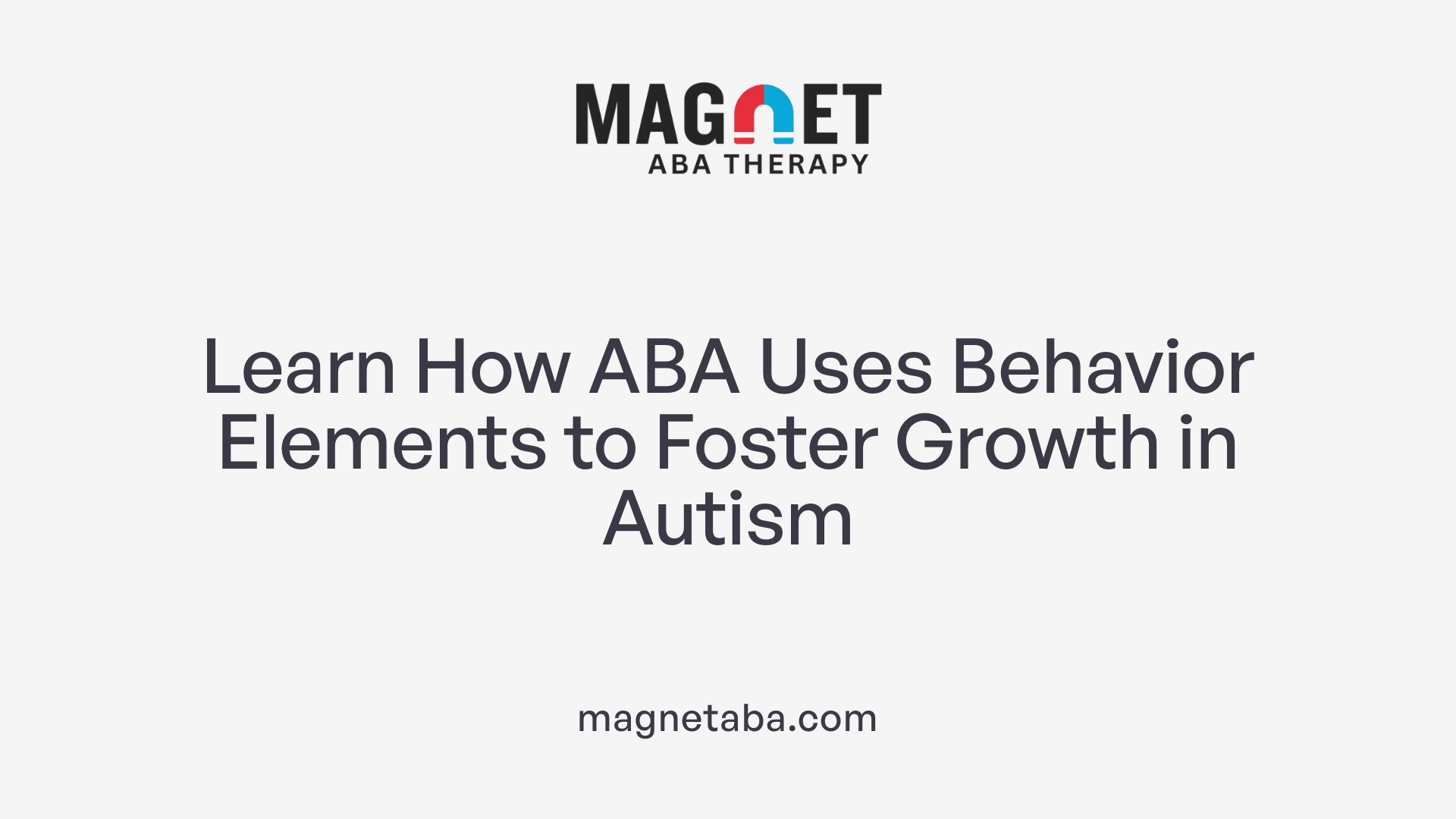Unveiling the Truth Behind ABA Therapy
Applied Behavior Analysis (ABA) therapy has long been a cornerstone in autism treatment, yet misconceptions and myths often obscure its true nature and benefits. This article explores and debunks common misunderstandings about ABA therapy, shedding light on its scientific foundations, ethical evolution, and individualized approach to empower those with autism and other developmental challenges.
What Exactly Is ABA Therapy and How Does It Work?

What is Applied Behavior Analysis (ABA) therapy and how does it work for autism?
Applied Behavior Analysis (ABA) therapy is a scientifically supported approach designed to improve behaviors and skills in individuals with autism. It works by carefully analyzing behaviors through the "ABCs"—antecedent (what happens before a behavior), behavior itself, and consequence (what follows the behavior). By understanding these elements, therapists can increase helpful behaviors like communication and social interaction, while reducing harmful or challenging ones.
The scientific basis and central principles
ABA is grounded in decades of research and endorsed by major organizations such as the U.S. Surgeon General and the American Psychological Association. The core principle is that behavior is learned and influenced by its consequences. Positive reinforcement—rewarding desired behaviors—is the foundational method used to encourage skill development.
Behavior modification techniques
Therapists apply a variety of teaching methods tailored to each individual's needs. These include structured practices like Discrete Trial Training (DTT), as well as more naturalistic methods such as Pivotal Response Treatment (PRT). These approaches break skills into manageable steps and use reinforcement to help children learn communication, social skills, daily living tasks, and more.
Focus on positive reinforcement
Unlike outdated methods that relied on punishment, modern ABA focuses exclusively on positive reinforcement. This means desirable behaviors are encouraged through meaningful rewards, fostering natural and sustainable learning without punishment or bribery.
Personalization of programs
ABA programs are not one-size-fits-all. Each plan is tailored based on thorough assessments of the child’s strengths, challenges, and family goals. Treatment evolves as progress is made, ensuring the therapy remains relevant and effective throughout development.
Modern practices vs outdated methods
Today’s ABA emphasizes play-based learning, natural interactions, and respecting the child's comfort and voice. Ethical standards prohibit aversive techniques and focus on collaboration with families and other professionals. This compassionate, science-driven approach aims to help individuals develop independence and improve quality of life—not to change who they are.
Who Provides ABA Therapy and How Is It Delivered?

Who typically provides ABA therapy for individuals with autism?
ABA therapy is provided by qualified professionals who are specially trained in Applied Behavior Analysis. Key providers include Board Certified Behavior Analysts (BCBAs), who design and oversee treatment plans, and Board Certified Assistant Behavior Analysts (BCaBAs), who support these efforts. Registered Behavior Technicians (RBTs), who work under supervision, deliver the therapy on a day-to-day basis. These professionals form a collaborative team that ensures high-quality and individualized care.
How is ABA therapy typically structured and delivered?
ABA therapy is a customized, data-driven approach tailored to each individual’s unique strengths, challenges, and goals. Treatment plans are created after thorough assessments and include skill-building activities focusing on communication, social interaction, self-care, and academic abilities. Therapy can be delivered in a variety of settings such as the home, clinic, or school, allowing flexibility to meet the needs of the individual.
Sessions are usually one-on-one and employ evidence-based techniques like discrete trial training and natural environment teaching. Positive reinforcement is central throughout, encouraging desired behaviors naturally and sustainably. Progress is carefully tracked via continuous data collection, allowing the team to adapt and refine the program based on ongoing results.
What role do families play in ABA therapy?
Parental and caregiver involvement is an integral part of ABA therapy. Families collaborate with therapists from the start to set meaningful goals aligned with the child’s and family’s values. They receive training and coaching to reinforce skills at home, ensuring consistency across environments and maximizing progress. This partnership also helps therapists stay informed about the child’s experiences outside therapy sessions.
How do therapy teams ensure ongoing effectiveness?
Behavior analysts continuously review collected data and consult with other professionals—such as speech therapists, occupational therapists, and educators—to provide comprehensive support. Treatment plans are regularly updated to reflect developmental changes and newly identified priorities, ensuring the therapy remains relevant and impactful over time.
Core Benefits of ABA Therapy for Those on the Autism Spectrum

What are the benefits of ABA therapy for individuals on the autism spectrum?
ABA therapy provides a wide range of benefits for individuals with autism, focusing on improving communication, social skills, and adaptive behaviors like daily living skills. These improvements help children not only express their needs better but also engage more fully with others and navigate everyday situations with greater ease.
How does early intensive intervention impact outcomes?
Early and intensive ABA therapy—often involving 25 to 40 hours weekly—has been shown to produce significant developmental gains. These include better language skills, enhanced cognitive function, improved social interactions, and increased independence. This early support can set a foundation for ongoing growth and reduce the challenges individuals face later in life.
Does ABA therapy focus only on reducing challenging behaviors?
ABA therapy goes beyond just reducing problematic behaviors. It emphasizes skill-building in critical areas such as communication, emotional regulation, self-care, and problem-solving. The goal is to equip individuals with the tools they need to lead fulfilling, independent lives rather than solely focusing on behavior management.
How does ABA promote independence and quality of life?
By teaching practical skills and encouraging positive, functional behaviors, ABA helps individuals achieve greater autonomy. This leads to improved self-confidence and a higher quality of life. Therapy targets meaningful goals tailored to each person's needs, which fosters not only skill acquisition but also overall well-being.
What is the evidence base and recognition behind ABA therapy?
ABA is a scientifically backed therapy supported by decades of research. It is recognized and endorsed by prominent health authorities such as the U.S. Surgeon General and the American Psychological Association, highlighting its effectiveness as a treatment for autism spectrum disorder.
Does ABA therapy support individuals across different ages and autism spectrum levels?
Yes, ABA is effective for a broad range of individuals, including children across the autism spectrum—from early childhood to adolescence. Treatment plans are personalized to developmental level and age, adapting goals to support academic skills, social confidence, and independence as the individual grows.
| Benefit Area | Description | Impact on Individuals |
|---|---|---|
| Communication Improvement | Enhanced ability to express needs and emotions | Reduces frustration and improves interactions |
| Social Skills Development | Teaching social cues, sharing, and cooperation | Promotes engagement and healthy relationships |
| Adaptive Behavior Growth | Focus on daily living skills like self-care and routines | Increases independence and life quality |
| Early Intensive Intervention | High-hour early therapy promotes cognitive and language gains | Sets foundation for lifelong progress |
| Individualized Skill Building | Personalized treatment targeting strengths and challenges | Supports holistic development |
| Age-Range Flexibility | Effective for toddlers to teens with tailored goals | Ensures continued growth across stages |
ABA therapy stands as a comprehensive, evidence-based approach that empowers individuals on the autism spectrum to develop skills essential for communication, independence, and enriched quality of life.
Dispelling Ethical Concerns and Misconceptions About ABA

History of Aversive Methods and Their Rejection
Early forms of ABA therapy sometimes involved aversive techniques such as electric shocks to reduce unwanted behaviors. These methods are now widely condemned and completely abandoned due to ethical concerns. Modern ABA practices emphasize kindness and respect for the individual, moving far away from any punitive measures.
Distinction Between Positive Reinforcement and Bribery
Positive reinforcement is central to ABA and involves rewarding desired behaviors to encourage their repetition naturally. This is different from bribery, which implies an insincere or manipulative reward. ABA ensures that reinforcement is meaningful and supports genuine learning and positive behavior change.
Emphasis on Kindness, Consent, and Autonomy
Modern ABA therapy prioritizes the child’s consent and autonomy. Techniques like assent-based ABA respect the individual's voice and comfort, making therapy collaborative rather than coercive. Consent is integrated into sessions to ensure the child feels safe and respected.
Modern Trauma-Informed and Assent-Based Approaches
Contemporary ABA incorporates trauma-informed care, recognizing the emotional and sensory experiences of individuals. Practitioners focus on creating supportive environments and tailored interventions that consider each person’s history, preferences, and needs, avoiding retraumatization.
Respect for Natural Behaviors Like Stimming
ABA acknowledges that certain behaviors, such as stimming (self-stimulatory actions), serve important self-regulatory functions. Instead of trying to eliminate these, ethical ABA seeks to understand and respect the natural purposes of such behaviors, ensuring they are not unnecessarily suppressed.
Importance of Individualized and Ethical Treatment
ABA therapy is highly personalized, with treatment plans developed collaboratively with families and tailored to the individual’s strengths, challenges, and goals. Ensuring ethical delivery means therapists maintain ongoing communication, avoid rigid protocols, and adapt to the child’s evolving needs—always prioritizing well-being and dignity.
Addressing Criticisms and Limitations
Critics often highlight concerns that ABA might be rigid, compliance-focused, or emotionally taxing if not thoughtfully applied. These risks underscore why ethical standards and individualized care are critical. Today’s ABA avoids outdated aversive methods and supports children’s autonomy while improving their communication, social skills, and independence.
This evolution in ABA reflects an ongoing commitment to ethical practice, safety, and respect for individuals, addressing past criticisms and aligning with contemporary values and science.
Beyond Autism: The Broader Applications of ABA Therapy
How is ABA therapy used beyond autism?
ABA therapy is widely recognized for its success in supporting individuals with autism, but its principles extend far beyond this population. Applied Behavior Analysis is effectively used in treating a variety of developmental and mental health conditions such as ADHD (Attention Deficit Hyperactivity Disorder), OCD (Obsessive-Compulsive Disorder), PTSD (Post-Traumatic Stress Disorder), and BPD (Borderline Personality Disorder). This versatility stems from ABA's scientific approach to understanding and modifying behavior, which can be tailored to address diverse challenges.
What roles does ABA play in education and health sectors?
In educational settings, ABA helps students develop adaptive behaviors, improve communication skills, and gain social competence. Its methodologies are employed to promote functional independence and academic success. Similarly, in healthcare, ABA supports behavioral health interventions, aiding individuals in acquiring self-care skills and coping strategies. This cross-disciplinary application highlights ABA's capacity to improve quality of life across various contexts.
How does ABA focus on adaptive and social skills training?
ABA therapy targets more than just reducing problematic behaviors; it emphasizes the development of practical skills essential for daily living and social interaction. Through individualized programs, ABA helps clients build communication abilities, emotional regulation, self-care, and problem-solving skills. Positive reinforcement techniques are used to encourage behaviors that promote social engagement and independence.
How is ABA personalized to meet diverse needs?
ABA programs are highly individualized, adapting methods to each person's unique cognitive and behavioral profile. Qualified professionals assess strengths and challenges to create customized treatment goals. This personalized approach ensures that interventions are relevant and effective whether addressing developmental delays, cognitive impairment, or emotional regulation difficulties.
Why is ABA recognized as a versatile tool across disciplines?
Endorsed by prominent organizations like the U.S. Surgeon General and the American Psychological Association, ABA's evidence-based framework and adaptability have established it as a respected method across multiple fields. Its ability to integrate with other therapies and incorporate family involvement further enhances its effectiveness across different populations and settings.
The Evolution and Modernization of ABA Therapy Practices
From Rigid Drills to Play-Based and Natural Learning
ABA therapy has evolved significantly from its early image of rigid, repetitive drills. Modern practices emphasize play-based learning and naturalistic environments, making therapy engaging and more relevant to everyday interactions. This shift supports skill development in settings where individuals naturally live and play, fostering happier and more motivated learners.
Embracing Sensory and Trauma-Informed Care
Contemporary ABA therapy integrates sensory considerations and trauma-informed approaches. Therapists recognize the unique sensory preferences and sensitivities of each individual, adjusting strategies accordingly to minimize distress and enhance comfort. This compassionate perspective helps build trust and promotes effective learning.
Collaboration and Advocacy with Autistic Communities
ABA practitioners today actively engage with autistic communities and advocates to ensure therapies reflect respect, dignity, and autonomy. This partnership encourages inclusion of autistic voices in therapy design and ethical standards, moving away from past misconceptions that aimed to "normalize" rather than support individuals' unique identities.
Incorporation of Innovative Techniques and Technology
Modern ABA employs a variety of advanced teaching methods, including Natural Environment Training, Pivotal Response Training, and Verbal Behavior Intervention. Additionally, technology such as apps and video modeling helps reinforce skills in dynamic ways, making therapy personalized and adaptable to individual needs.
Centering Self-Advocacy and Autonomy in Therapy
A crucial advancement in ABA is the focus on empowering individuals through self-advocacy and autonomy. Techniques promote meaningful consent and choice, respecting children’s comfort and voice throughout therapy. This approach aims to build not only skills but also confidence and independence for lifelong success.
| Evolution Aspect | Description | Impact on Therapy |
|---|---|---|
| Play-Based Learning | Use of natural, engaging activities | Increases motivation and real-life skill transfer |
| Sensory and Trauma-Informed Care | Adapts to sensory needs and past experiences | Enhances comfort and effective learning |
| Community Engagement | Collaboration with autistic advocates | Promotes respectful, ethical treatment |
| Innovative Techniques | Use of diverse, technology-supported methods | Tailors therapy to individual learning styles |
| Self-Advocacy Focus | Encouraging choice and autonomy | Builds independence and confidence |
The Critical Role of Families in ABA Success
Why is parent and caregiver training important in ABA therapy?
Parent and caregiver training is essential in ABA therapy because it empowers families to reinforce skills learned during sessions at home. Trained parents can help maintain consistency and encourage the natural use of new behaviors in everyday settings.
How does collaborative goal setting benefit ABA outcomes?
Collaborative goal setting ensures that therapy goals align with the child’s unique needs and family values. When parents and therapists work together to define objectives, it increases motivation and relevance, fostering more meaningful progress.
Why is consistency across home, school, and therapy important?
Consistency across environments such as home, school, and therapy maximizes skill acquisition by providing multiple opportunities to practice and generalize learned behaviors. It helps children apply skills flexibly and reduces confusion.
What does family-centered treatment planning involve?
Family-centered treatment planning involves tailoring ABA programs to fit the family’s routines, preferences, and cultural values. It respects parents as partners and supports them in navigating therapy while balancing family life.
How are parents supported to reinforce skills and encourage independence?
Professionals offer parent coaching, training sessions, and resources to build confidence in reinforcing positive behaviors. This ongoing support helps families promote skill development and encourages children’s independence.
Family involvement is a cornerstone of effective ABA therapy, creating a collaborative, supportive environment that enhances progress and sustains gains across all areas of development.
Debunking Myths to Embrace Evidence-Based ABA Therapy
ABA therapy, backed by decades of scientific research and major health endorsements, is a dynamic and individualized approach that extends far beyond outdated stereotypes. Understanding its principles, providers, benefits, ethical safeguards, and modern adaptations is essential to dispel myths and appreciate ABA’s true value. Rooted in respect, positive reinforcement, and collaboration, ABA therapy empowers individuals with autism and other developmental challenges to build skills, gain independence, and improve their quality of life. As the field continues to evolve with insights from autistic communities and innovations in practice, embracing accurate information will help families, professionals, and society support effective and compassionate care.
References
- Debunking 7 Common Myths About ABA Therapy - GSEP Blog
- 10 Common Misconceptions About ABA
- 8 Common Myths About ABA Therapy Debunked
- From Confusion to Clarity: Debunking ABA Misconceptions ...
- Debunking Common Myths About ABA Therapy
- Debunking Common Myths About ABA Therapy
- Debunking Myths: Common Misconceptions about ABA ...
- 7 Myths About Applied Behavior Analysis












